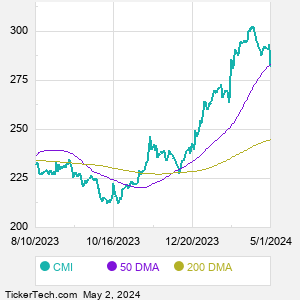Cummins is a diesel engine manufacturer. Co.'s segments are: Engine, which manufactures and markets diesel and natural gas-powered engines; Distribution, which is Co.'s primary sales, service and support channel; Components, which supplies aftertreatment systems, turbochargers, transmissions, filtration products, electronics and fuel systems for commercial diesel and natural gas applications; Power Systems, which includes power generation, industrial, and generator technologies product lines; and New Power, which designs, manufactures, sells and supports hydrogen production solutions and electrified power systems ranging from fully electric to hybrid along with components and subsystems.
When researching a stock like Cummins, many investors are the most familiar with Fundamental Analysis — looking at a company's balance sheet, earnings, revenues, and what's happening in that company's underlying business. Investors who use Fundamental Analysis to identify good stocks to buy or sell can also benefit from CMI Technical Analysis to help find a good entry or exit point. Technical Analysis is blind to the fundamentals and looks only at the trading data for CMI stock — the real life supply and demand for the stock over time — and examines that data in different ways. One of these ways is called the Relative Strength Index, or RSI. This popular indicator, originally developed in the 1970's by J. Welles Wilder, looks at a 14-day moving average of a stock's gains on its up days, versus its losses on its down days. The resulting CMI RSI is a value that measures momentum, oscillating between "oversold" and "overbought" on a scale of zero to 100. A reading below 30 is viewed to be oversold, which a bullish investor could look to as a sign that the selling is in the process of exhausting itself, and look for entry point opportunities. A reading above 70 is viewed to be overbought, which could indicate that a rally in progress is starting to get crowded with buyers. If the rally has been a long one, that could be a sign that a pullback is overdue. |



